
North America has delivered double digit growth in volume and value annually over recent years, with receipts growing at a faster rate than from other
markets. The number of nights spent in the country by North American visitors increased by 50% between 2012 and 2016 and have yielded a higher
average daily expenditure than most other nationalities. Based on arrivals year-to-date it is apparent that were it not for the continuing robust visitor
growth from North America, along with other long haul markets, Ireland would be facing a drop in earnings in 2017. The downturn in visitors from Britain is
projected to cost up to €100 million drop in earnings, while it is likely that the North American market will generate an extra €200 million thereby cushioning the
decline in revenue from the UK and what appears to be a lack lustre year from mainland Europe.
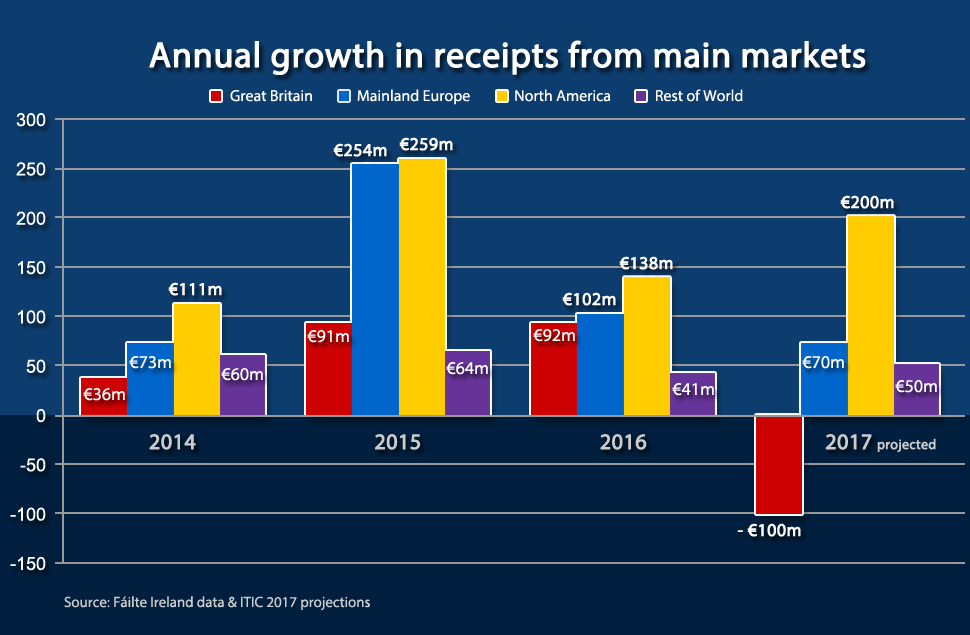
Looking to 2018 and beyond, the Irish tourism industry is faced with the question of how best to ensure that valuable growth from North America can be sustained.
Continued growth from the North Amerian market is essential to offset the uncertain and difficult trading environment in Ireland’s short haul source markets as Brexit continues to threaten
a collapse of the demand from Britain and euro spending tourists find the UK a more attractive value destination to Ireland.


Ireland welcomed an estimated 1.48 million visitors from North America in 2016, 1,294,000 US residents and 183,000 Canadian residents. Expenditure by North American visitors in the country was estimated at €1.33 billion in 2016.
Projections for the current year suggest circa 1.7 million visitors spending almost €1.5 billion, based on double digit growth year to date.
Volume and revenue growth from North America continues to outpace the overall growth in overseas tourists to Ireland. Visitors from this market while
accounting for close to 17% of total visitors to the country generate almost 30% of tourism receipts. Tourism earnings from North America have overtaken
the receipts from Britain, the largest volume market, since 2014 and are closing the gap on receipts from mainland Europeans.
North American visitors are especially valuable and tick the boxes of most strategic objectives for the Irish tourism industry. Compared to other visitors the distinguishing
characteristics include:
- Big spenders, with daily expenditure higher than most other nationalities;
- The majority (70%) specifically chose Ireland for a vacation, a higher proportion than from any other market;
- Expanding air lift as carriers invest in transatlantic routes;
- Good customers for hotels, guesthouses and B&Bs, due to a higher incidence of use of paid serviced accommodation;
- Good geographic spread throughout the country with touring holidays particularly popular using hired cars, coaches and public transport (although
the incidence of ‘Dublin only’ visits from the market is increasing);
- Almost 30% purchase an inclusive tour arrangement;
- Excellent well established in-market distribution networks;
- Good seasonal spread of demand; and
- Source of high end convention and incentive travel groups
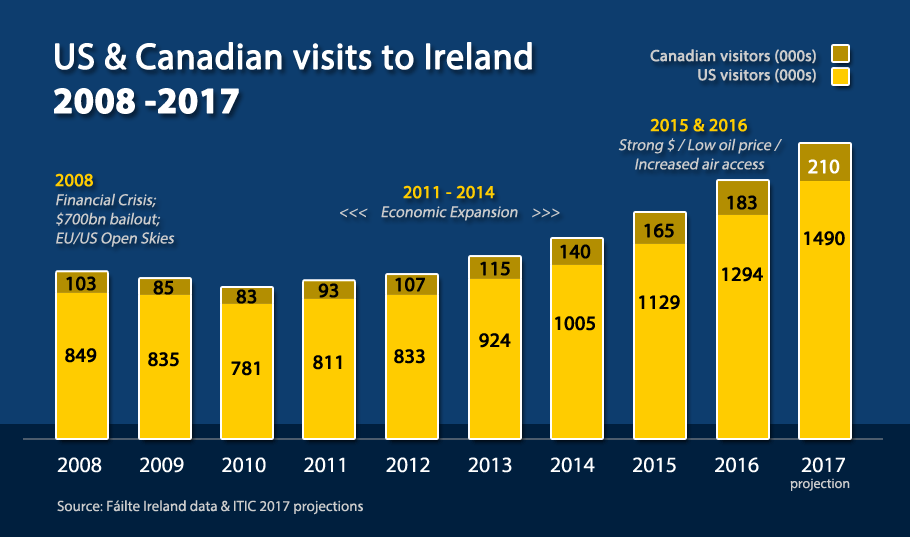
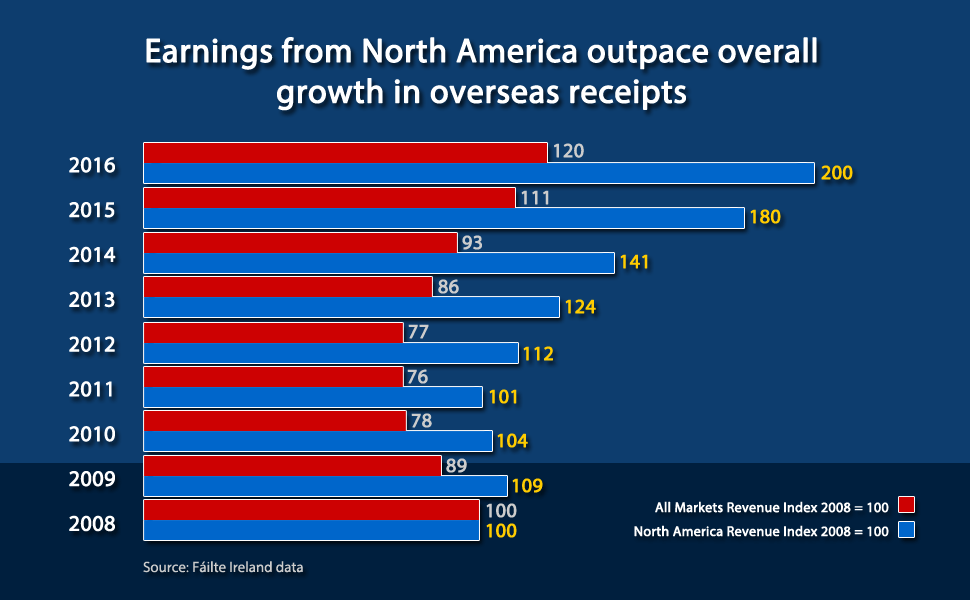
The relative importance of North America and the growing dependence of Irish tourism on the market is now clearly evident.
In volume terms growth from North American has outpaced the overall growth in visitors to Ireland with the market’s share of total arrivals
increasing from 13% in 2008 to 17% in 2016 (projected to increase further in 2017). US visitors now account for 15% of total visits up from 11% in
2008.
The North American market is more significant in value than in volume terms. Receipts from North American visitors have doubled over the period
2008-2016, while total overseas tourism receipts have increased by 20%. Last year North American tourism receipts accounted for 29% of total
tourism income, compared 17% share in 2008. Earnings from the market in 2017 are expected to be close to €1.5bn.
Based on current performance annual earnings from the market in the current year will be double what they were in 2012, following five years of sustained
annual growth in demand.
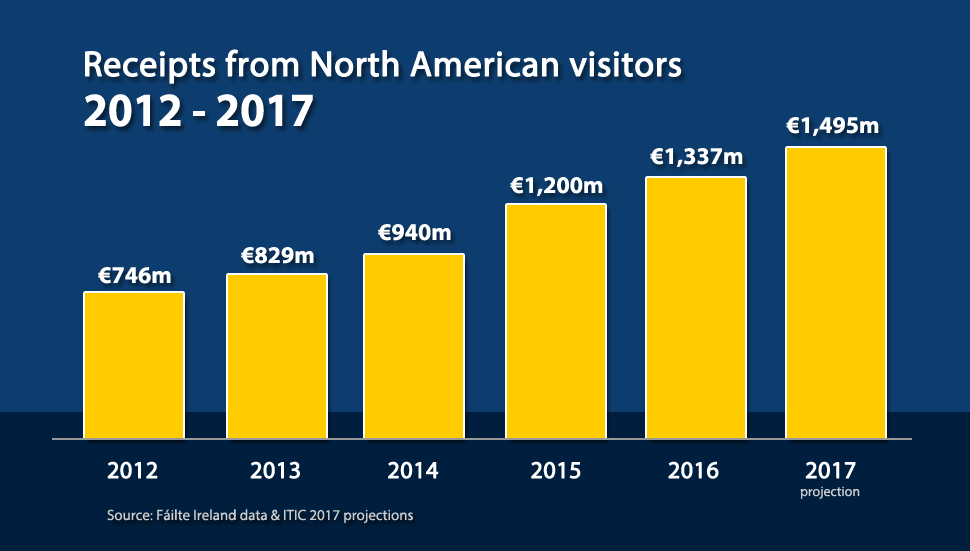
North Americans are an increasingly important share of discretionary visitors to Ireland – now accounting for almost one in four (24%) holiday visitors,
having grown from a 17% share in 2008. The overall number of overseas holiday visits has increased by 23% over the period while holiday visits from
North America grew by a remarkable 70%.



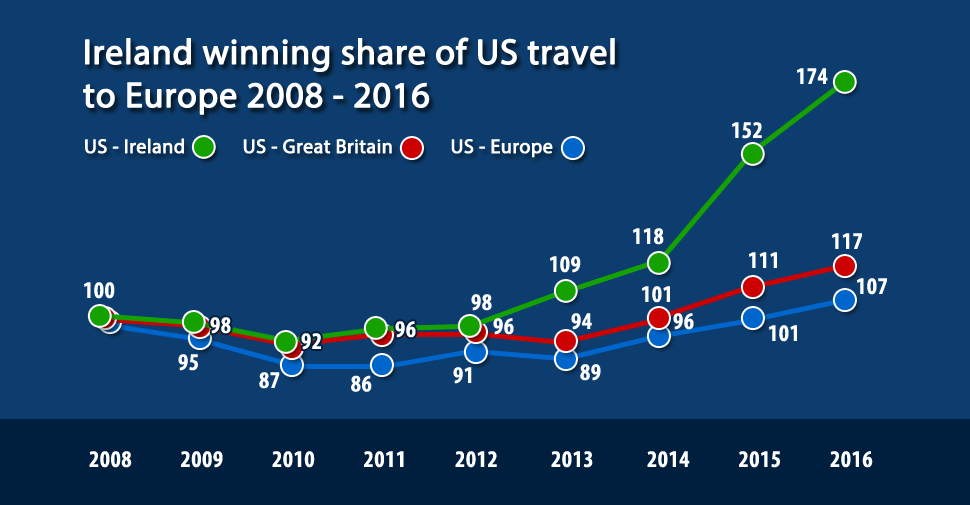
In recent years Ireland has significantly outperformed the overall US to Europe travel market as well as travel from the US to Great Britain, Ireland's closest
competitor and major gateway for Americans visiting Europe.
While demand for each of the destinations paralleled each other closely over the period of the economic downturn and recovery between 2008 and 2012, it is evident that Ireland
began to gain market share with demand growing at a faster pace from 2013 onward. Air access increases over the last 3 years have coincided with a strengthened US dollar and this has driven strong growth in North American tourism traffic to Ireland. Effective marketing of Ireland as a destination has also been impactful during this period.


Factors underpinning growth from North America
Other than the economic downturn following the financial crisis of 2008 and 2009, the US economy has been consistently in an expansionist phase.
Disposable personal income has increased each quarter without interruption since Q1 2013.
Latest data shows that GDP growth rebounded a little more than initially reported in Q2 2017, as real GDP grew 3.1%, up from 1.2% in the first quarter,
according to the third estimate from the Bureau of Economic Analysis. Consumer spending gains accelerated and accounted for nearly three-quarters of
GDP growth. Fixed investment trade and inventories also made positive contributions. Real disposable income increased 3.3% after rising 2.9% in the first
quarter.
Economic growth is projected to continue to pick up in 2018 as headwinds from past exchange rate appreciations abate and support from fiscal policy
begins to appear. Consumer spending is expected to benefit from continued, though slowing, employment gains and, as the labour market tightens,
stronger wage growth. With inflation nearing its target and unemployment edging down further, monetary policy stimulus has begun to be withdrawn
gradually. As growth picks up, interest rates are projected to rise to contain inflationary pressures and reduce the risk of financial-market distortions. The
Administration and Congress are formulating plans to cut taxes and boost infrastructure spending. The latest Congressional Budget Office’s projection
assumes no spending increase at the federal level, but a tax reform is projected, which will support consumer spending and investment in 2018 and beyond.
US Consumer Sentiment Jumps to Near 14-Year High
Consumer sentiment rose to 101.1 in October 2017 from 95.1 in September, well above market expectations and the highest level since January 2004,
according to the latest University of Michigan index. The October gain would appear to have been broadly shared across all age and income subgroups,
irrespective of political viewpoints, suggesting a robust outlook for consumer spending that extends into 2018. While the surge indicates greater optimism
about the future course of the economy, it also reflects an unmistakable sense among consumers that economic prospects are now about as good as could
be expected. The outlook is supported by a moderation in the expected pace of growth in both personal finances and the overall economy, accompanied by
a growing sense that, even with this moderation, it would still mean the continuation of positive economic times.
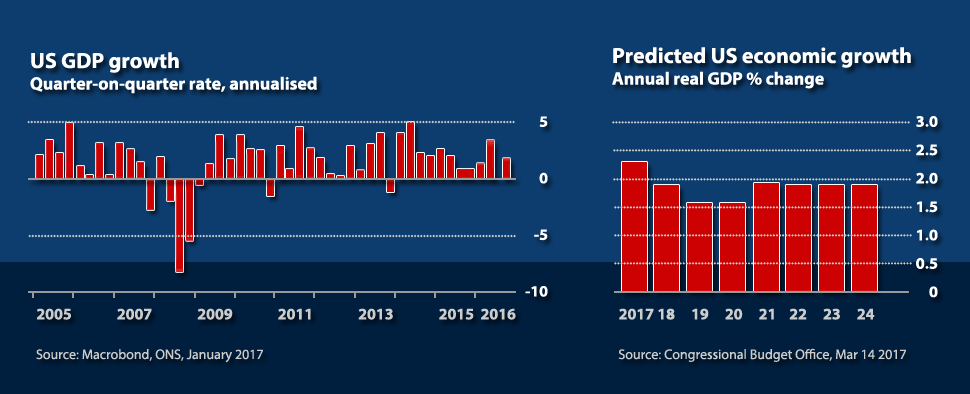
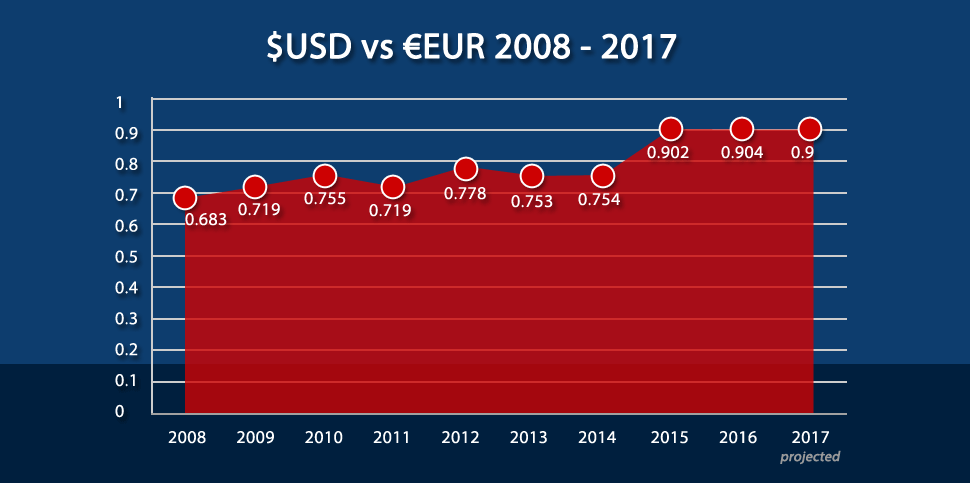
On July 15 2008, following the start of the financial crisis the dollar euro exchange rate hit a 10 year low at €0.625 but recovered to hover close to €0.70 in
the aftermath of Lehman Brothers collapse. A significant strengthening of the dollar vs the euro has occurred over the past 3 years at close to €0.90, an effective
30% increase in value. The US dollar reached a 10 year high against the euro in December 2016 buying €0.965. The average over the ten year period was €0.7805. However, since the start of 2017, the dollar has fallen back in value to buying an average of €0.84 during September.


The expansion of direct air services from the US and Canada over recent years has provided a driver for double digit growth in visitor demand. Ireland has
enjoyed annual increases in capacity in excess of growth in airline services between North America and Europe. Over the past 5 years capacity has more
than doubled (+114%). In summer 2017 Ireland was served by 6 airlines from 14 airports in the US (with Miami being added in September), while 5 airlines
provided service from 5 airports in Canada as capacity and frequency almost tripled over recent years.
Aer Lingus has led the expansion of transatlantic air services, reintroducing west coast gateways, increasing frequencies on established routes and opening
new gateways, while US carriers also added capacity. 2017 saw the arrival of Norwegian International into the Ireland-US market, as well as intensive promotion
of new low fare indirect routings.
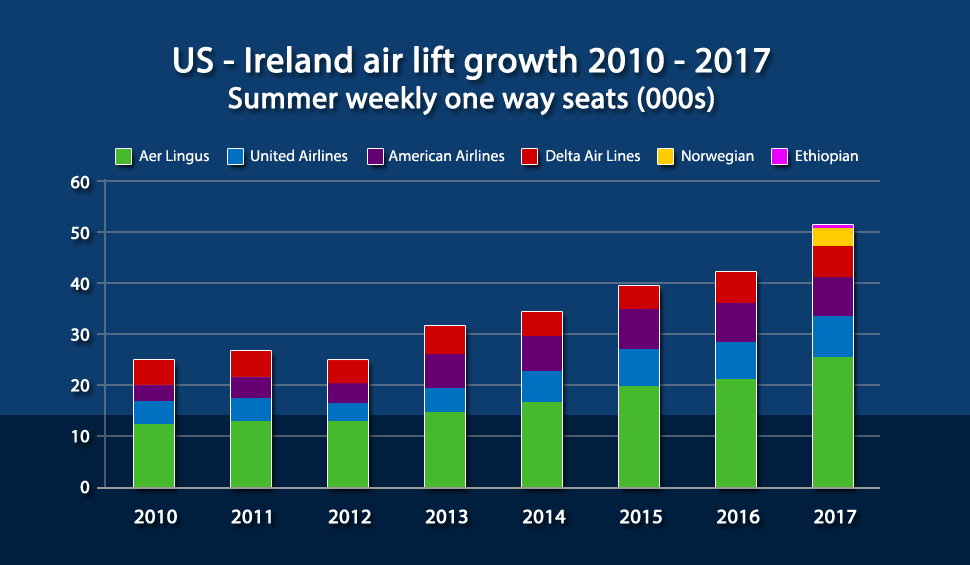

Aer Lingus hub strategy for transatlantic traffic is supporting an ever expanding sustainable network of routes and frequency which is benefitting inbound
tourism. Dublin Airport has seen a 67% increase in transatlantic traffic over the past five years to become the fifth largest airport in Europe for North
American connectivity after London Heathrow, Paris CDG, Frankfurt and Amsterdam.
Aer Lingus is delivering on its promise to further build connectivity between Europe and North America with the announcement of a record trans-Atlantic
network for summer 2018, including a new service to Philadelphia. The growth is built on the back of an investment from parent company International
Airlines Group (IAG) in new aircraft: four new long haul aircraft have already enabled new routes to Hartford, Los Angeles, Miami and Newark over the past
24 months. The airline is planning its largest ever transatlantic programme in 2018 with 2.75 million seats and is targeting sustained growth, contingent on
adequate infrastructure at Dublin Airport. Aer Lingus is taking delivery of a fleet of eight A321neo (LR)s aircraft between 2019 and 2020. The new aircraft would give
Aer Lingus the potential to go from the 2.5 million transatlantic passengers it carries today to 4.5 million passengers annually.
As Irish tourism braces itself for cooler Brexit winds, tourism traffic from North America is set to grow further in importance. The forthcoming agency-industry strategic review of the US market is timely as North America’s performance is critical to Irish tourism prospects in the years ahead.

|
